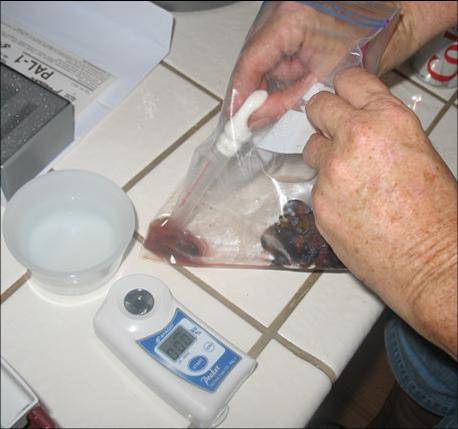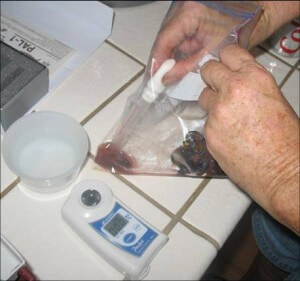This is not a treatise on the chemistry of testing grapes and wine, but more of a litany of complaints on our limitations regarding this aspect of the process. As I have often mentioned, if I’d known there was so much chemistry involved in wine making, I would have paid more attention in high school chemistry class!
As it is, we have taken a semester class in wine making at Mira Costa Community College, a weekend class in grape growing, listened to numerous speakers on the topics at our monthly Ramona Valley Vineyard Association, taken several day and half-day classes and have a shelf full of books.
The first test each year is to find out the sugar level in the grapes, or “Brix”. Table grapes have a Brix of about 18. In order to make wine, the wine grapes need a Brix of about 23 to 27 depending on the wine and the winemaker. At the recommendation of one of our wine making friends, Jim Hart of Hart Winery in Temecula, we bought a digital, temperature compensated, refractometer. So that test of the grapes is easy and actually kind of fun.
Wine makers also want to know the pH and the Acid of the grapes prior to harvest. We purchased a Heavy Duty ph, mV & Termperature meter, also digital. We got two bottles of Standard Reference Solution, one 4.01 for calibration of the pH meter and 7.0 for calibration and electrode storage. I forget how this all works, since we haven’t used it in months, but I recall it was not too bad, if we both worked it together and had the instruction book in our hands.
There’s TA testing, which measures the amount of total acids in the wine or must – and there’s a kit for that which involves solutions and eye droppers and measuring and looking at the color of the juice in the test tube. Again, haven’t done that one in awhile, but recall the two of us were able to figure it out. You might get the impression that between the two of us, we’re one hell of a wine maker!
And then there’s SO2 testing. This is apparently a critical tool to being able to properly prevent the wine from oxidation and spoilage organisms, according to all our manuals, books and handouts, as well as “MoreWine” where we buy a lot of our supplies. We added SO2 at crush last harvest, which was an easy calculation, since our San Diego County wine making guru Lum Eisenman has a chart that tells us how much SO2 to add to how many pounds of grapes. It’s not much – measured in parts of teaspoons.
We knew we were supposed to test the level of SO2 in the wine regularly to be sure it was at the correct level, but we didn’t know how to test for it. At a recent seminar led by local winemaker John York of Hellanback Ranch Winery, we were advised to at least get a Titret kit, which is test that will give an approximation – not 100% accurate and therefore easy for beginners but not used by the pros who use a more sophisticated testing set up. So we ordered in Titrets and a Titret Holder. Last Saturday we racked our little batch of 15 gallons of wine, and got out our new SO2 testing equipment. We both read the instructions and came up blank. We got out our various manuals, books and handouts on the topic and got nothing. It seemed like we were missing a piece of the equipment,a so-called “Valve Assembly”. We gave up.
We tasted the wine, and by some miracle it tasted pretty darn good. We found a line in an instruction somewhere that said add 1/4 teaspoon of SO2 to 5 gallons. So we did, whether it needed it or not. Additionally we were told to keep a pistol grip sprayer solution of SO2 and water on hand to sanitize everything that touches the wine, like the carboys, the airlocks that go in the top of the carboys, etc. NOWHERE does anyone tell you what that solution should be! We took a wild guess and put 1/4 teaspoon in a quart sprayer.
Sunday I’d had enough and went to Hawk Watch Winery to pick up my Wine Club order and taste their lovely wine. Owner/winemaker Mike heard my litany of problems with SO2 and Titrets so took me to his lab and gave me a demonstration. Turns out the valve assembly is a little tiny, nearly invisible accessory, nestled in the box with the Titrets (test tubes). Put your glasses on Elaine.
Cheers,
Elaine


